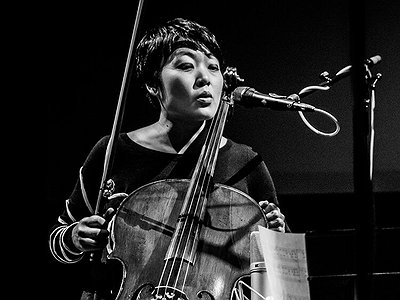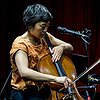Part 2
What were some of the most interesting tuning systems you tried out and what are their respective qualities?
Basically I've been working in just intonation and creating work through looking at this system in two different ways. The first is using a tuning lattice which extends to the 13th overtone and the second is Harry Partch's 11-limit tonality diamond.
The lattice tends to inspire chords and harmonies, whereas the diamond seems to inspire melodic writing more easily. The territory is so vast and I realize how much the system I decide to use affects the music I write, so I am in an ongoing process of researching and deepening my understanding and approach.
Tell me a bit about recording Harbors, please. Can you talk a bit about the "extended harmonics of the open strings of the cello" that are mentioned in the press release?
Several years ago, in order to understand more about how harmonics are generated on the cello, I created a diagram of the first 13 overtones of all four strings. I mapped out both the pitches of the harmonics and the corresponding pitches when the string is stopped or pressed down at the harmonic nodal points. The pitches are all indicated as ratios to the fundamental of 1/1 = A 216 Hz. Ellen created a diagram as well and we both drew from this pitch material to begin composing Harbors.
What I love is that when we were deep in the middle of writing this piece, I opened up Cris Forster's book, "Musical Mathematics" and saw a diagram of the ancient Chinese qin (one of my favorite instruments!) and the diagram of pitches mapped out a similar system; that is, stopped notes and flageolet notes, but only up to the 5th harmonic. I somehow feel this approach to playing the cello is embedded in my genetic memory.
The strings of the LSI are tuned to pitches that all exist as either harmonics or stopped nodal points on the cello, and all the material I play in the piece come from this source as well. The recorded work is a result of composing, performing, and revising the composition over a period of four years.
Naturally we each had other projects going on, so each time we had a gig, we would carve out time to develop the piece. We both created midi versions of our instruments sampling the basic string sound and also using a tuning script in order to play justly tuned pitches on a keyboard. We each generated compositional structures this way on our own, and then came together to develop and shape the ideas on our instruments.
When you're performing with such a giant – at least in terms of its physical expansion – instrument like the LSI, how does this affect your own performance with the relatively speaking humble cello? What is the experience like of playing duos with such an instrument like?
The challenge for me is not to play the cello in a soloistic way and turn the LSI into an accompaniment and also not to simply play long tones and be redundant in the LSI's massive sound.
In Harbors we achieved this through various approaches. The first was to amplify and expand the cello through four speakers (two stereo channels panned diagonally) in order to create a more spatial and ambient palette. Through simple looping, I can create texture beds that take the instrument out of its monophonic limitations. This allows me to define a more three-dimensionally sculpted space through panning, timing and volume variation.
The other way of defining the cello's counterpoint is to draw upon the unique characteristics of my playing techniques such as glissandi, pizzicato harp harmonics, ricochet and flautando bowing. However, at times I do indeed simply play long bowed tones and consciously aim towards a phenomenon we call bloom. This happens when a tone of the cello sympathetically resonates and/or amplifies a frequency that is already sounding on the LSI, or triggers an overtone or subtone that isn’t yet sounding, thus causing an existing chord to suddenly ‘bloom’ into a slightly shifted harmonic structure.
With electronic tools, playing and composing in just intonation has become a whole lot easier. Do you find this interesting?
Absolutely! I love the accessibility that technology affords to explore and hear different tunings. Of course many of these tools are still awkward to use, but at least they exist and are being developed!
My current discoveries include designing midi controller layouts on an iPad via TouchOSC and using this to replicate and compose with Partch's 11-limit diamond as well as using the music notation software Dorico, which can score and play back music in Helmholtz-Ellis notation, designed by Marc Sabat and Wolfgang von Schweinitz.
You also run the fo’c’sle label. Would you say that tuning is an important topic for the artists on your label?
Not necessarily. What I value is open-mindedness. There are some artists on the label who work primarily in equal temperament. I believe that all tuning systems can generate great music and want to present that philosophy rather than being exclusive about tuning. Showing a diversity of approaches to music making is what excites me.






